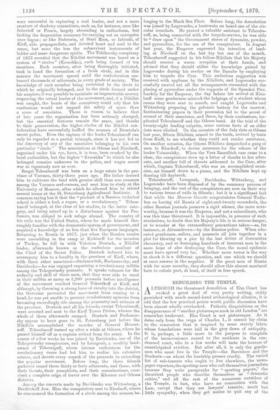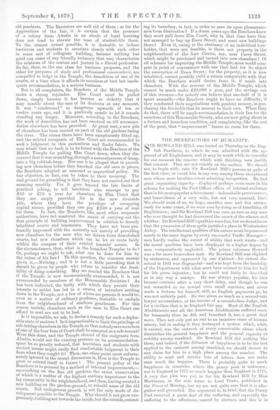REBUILDING THE TEMPLE. A LTHOUGH the threatened demolition of Elm Court
has evoked a great deal of very pretty writing, richly garnished with much second-hand archteological allusion, it is odd that the few practical points worth public discussion have been almost wholly overlooked. Pathetic disquisitions on the disappearance of "another picturesque nook in old London " are somewhat irrelevant. Elm Court is not picturesque. As it dates only from the reign of Charles I., it cannot lay claim to the veneration that is inspired by some stately fabric whose foundations were laid in the grey dawn of antiquity. It is, perhaps, a little more to the purpose to complain of the inconvenience caused to the residents in the con- demned court, who in a few weeks will taste the horrors of unanticipated eviction. But after all, it is only the gentle- men who must live in the Temple—the Barristers and the Students—on whom the hardship presses cruelly. The varied list of sub-tenants who ought to live elsewhere, the news- paper reporters, the sporting-men who call themselves journalists because they write paragraphs for "sporting papers," the theatrical people who describe themselves as "dramatic critics," and all the rest of the numerous outsiders of the Temple, in fact, who have no connection with the Law, except that they are lawyers' tenants, merit but little sympathy, when they get notice to quit any of the old precincts. The Banisters arc well rid of them ; as for the Apprentices of the Inn, it is certain that the presence of a colony from Alsatia in an abode of legal learning does not tend to elevate the tone of student-life there. To the utmost extent possible, it is desirable to induce barristers and students to associate closely with each other in some sort of collegiate building, because nothing but good can come of any friendly intimacy that may characterise the relations of the seniors and juniors in a liberal profession. So far, then, as the one class for business purposes, and the other for purposes of study and professional camaraderie, are compelled to lodge in the Temple, the demolition of one of its courts, at a time when it affords its members at best but inade- quate accommodation, is a serious business. But to all complaints, the Benchers of the Middle Temple make a strong rejoinder. Elm Court must be pulled down, simply because it has become so ricketty that it may tumble about the ears of its denizens at any moment. It was " condemned " as dangerous upwards of ten or twelve years ago, and it is positively unsafe to let it remain standing any longer. Moreover, according to the Benchers, the work of demolition has not been resolved on till accommo- dation elsewhere has been provided. At great cost, a new pile of chambers has been erected on part of the old gardens facing the river. The rooms there have been sumptuously fitted up, and the evicted occupants of Elm Court are recommended to seek a lodgment in this pretentious and flashy fabric. We may admit that no fault is to be found with the Benchers of the Middle Temple for pulling Elm Court down, when they dis- covered that it was crumbling, through a natural process of decay, into a big rubbish-heap. Nor can it be alleged that in provid- ing new chambers before they knocked the old ones to pieces, the Benchers adopted an unsound or unpractical policy. No fair objection, in fact, can be taken to their meaning. The real ground for grumbling is that they have not carried out that meaning sensibly. For it goes beyond the fair limits of practical joking, to tell barristers who manage to pay £60 or £70 a year for chambers in Elm Court that they are amply provided for in the new riverside pile, where they have the privilege of occupying capital rooms, provided they can pay £200 a year of rent for them. In fact, the Benchers, like, most other corporate authorities, have not mastered the secret of carrying out the first principle of building improvement in relation to densely inhabited courts and tenements. They have not been pro- foundly impressed with the necessity not merely of providing new chambers for the men who are driven from demolished courts, but new chambers which can be let at rents fairly within the compass of their evicted tenants' means. In the circumstances, then, what is the homeless Templar to do ? Or, perhaps we ought to ask, what can be done for him by the rulers of his Inn? To this question, the common answer given is,—Nothing ; and it is not a little provoking that it should be given by people who refuse to consider the feasi- bility of doing something. May we remind the Benchers that if the Temple is now inconveniently overcrowded, it is not overcrowded by members of the Honourable Societies? As has been indicated, the laxity with which they permit their tenants to sublet has led to a swarm of intruders settling down in the Temple, not a few of whom are persons it would be, even as a matter of ordinary prudence, desirable to exclude from the neighbourhood of studious gentlemen. For this reason mainly, chambers such as the men in Elm Court can afford to rent are not to be had.
Is it impossible, we ask, to devise a remedy for such a deplor- able state of matters Is it impracticable to limit the privilege of sub-letting chambers in the Temple, so that nobody save members of one of the four Inns of Court shall be accepted as a sub-tenant? Were this done, and the Temple cleared of the emigrants from Alsatia, would not the existing pressure on its accommodation- space be so greatly reduced, that barristers and students with modest means might easily find comfortable lodgment in their Inns when they sought it? Then, one other point most unfortu- nately ignored in the recent discussions is, How is the Temple to grow or extend itself in future ? The present policy of the Benchers is to proceed by a method of internal improvement,— encroaching on the fine old gardens, the strict conservation of which is a matter of the highest sanitary importance to the lay community in the neighbourhood, and then, having erected a new building on the garden-ground, to rebuild some of the old courts. But endogenous growth is not the only mode of de- velopment possible to the Temple. Why should it not grow exo- genously, building not towards the inside, but the outside,extend- ing its boundary, in fact, in order to save its open pleasaunce- area from diminution If a dozen years ago the Benchers knew they must pull down Elm Court, why in that time have they not managed to buy up Essex Street, and erect new buildings there? Even if, owing to the obstinacy of an individual free- holder, that were not feasible, is there not property in the neighbourhood of the Law Courts, say, near Carey Street, which might be purchased and turned into new chambers ? Of all schemes for improving the Middle Temple, none could com- pete in point of convenience with one that had for its object the annexation of Essex Street ; for the property, as it is now inhabited, cannot possibly yield a return comparable with that which the Ben chers would derive from it, if made into chambers. With the revenue of the Middle Temple, which cannot be much under £.20,000 a year, and the savings out of this revenue—for nobody can believe that one-half of it is spent annually—the Benchers ought to have no difficulty, if they conducted their negotiations with prudent secrecy, in pur- chasing the freeholds that lie nearest to their own. When they do that, there will be ample accommodation in their Inn for the members of this Honourable Society, who are now going about in a forlorn and homeless condition, and complaining, like the rest of the poor, that " improvement" leaves no room for them.































 Previous page
Previous page